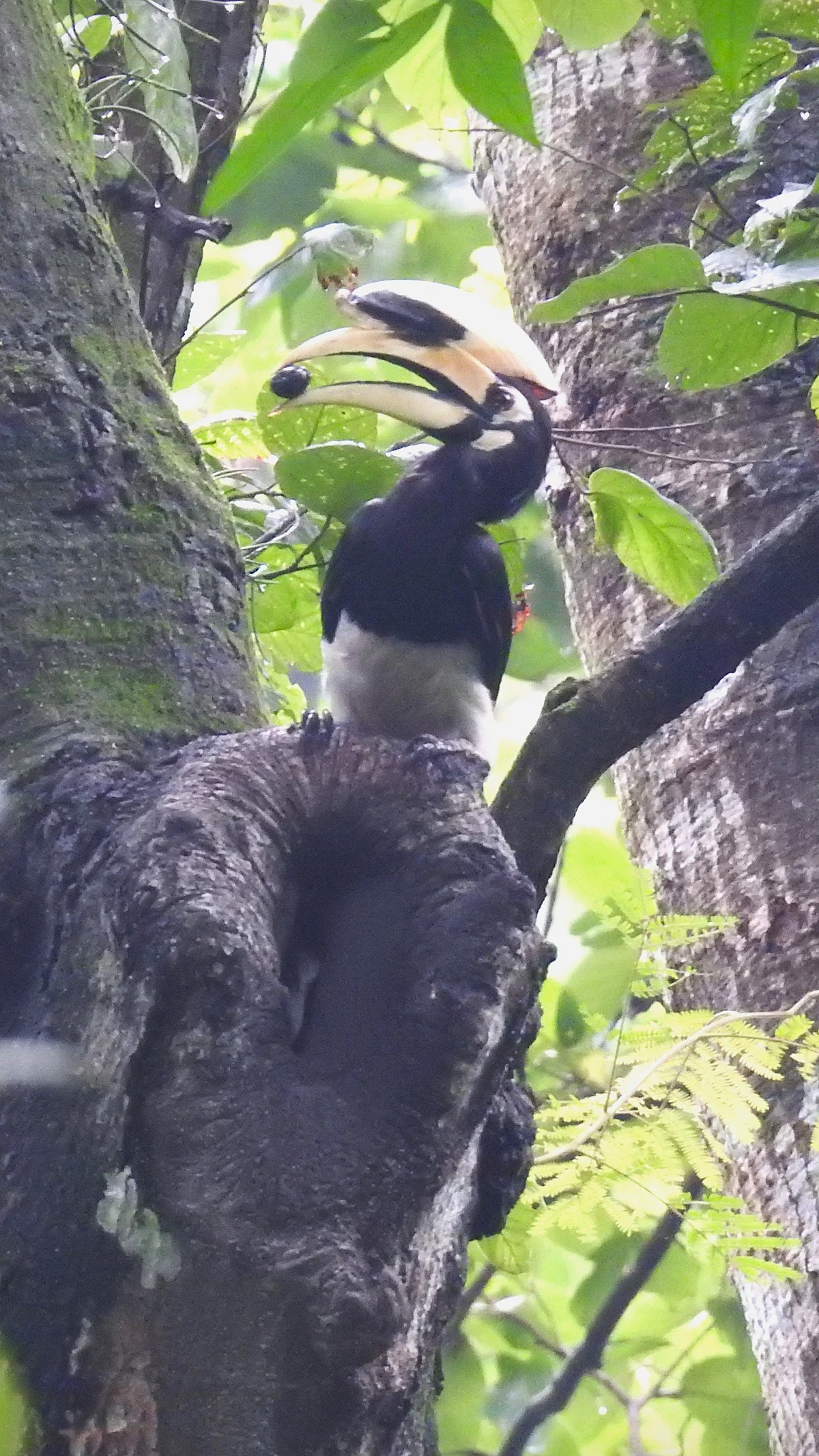Saving hornbill homes with communities
Human beings are part of nature and therefore it is vital to have community participation in conservation activities. This is especially true while attempting to implement conservation programs where good quality forests still exist outside Protected Areas.
Hornbill Breeding Biology
Hornbills naturally occur in low densities and are slow breeders. They are also monogamous birds, with a long breeding season which involves intensive parental care. These birds nest in large softwood trees with existing cavities. During the breeding season, hornbill pairs find a suitable cavity. The female then seals herself inside this cavity with droppings and mud and lays eggs, leaving only a slit for the male to bring back food for the family. Their biology thus makes them extremely vulnerable to hunting, and habitat loss, which results in loss of breeding individuals from the population and loss of nesting sites respectively.
Hornbills in Pakke
Since 2003 we have been studying hornbills and monitoring their nests in the Pakke Tiger Reserve(PTR), in the East Kameng District, Arunachal Pradesh. Aspects of hornbill biology were studied in PTR from 1995-2000.
Pakke is a haven for hornbills in North-east India, with four of the nine species - the Great Hornbill, the Wreathed Hornbill, the Oriental Pied Hornbill and the Rufous-necked Hornbill- found here. This makes the area extremely important for hornbills, especially considering that hunting and habitat loss threatens hornbill species in the rest of Northeast India. Hunting has declined; however threats remain due to deforestation in the foothill forests outside the PA. These forests are crucial habitats for hornbill nesting and roosting. Our long-term monitoring of hornbill nests outside the PTR suggested that there was increased direct competition for nests between hornbill species due to limited availability of nest sites.
It was in this context that we set out to work with the dominant tribe in Pakke, the Nyishi community. The Nyishi use the upper beak/casque of the Great/Rufous-necked hornbill in their traditional headgear, the fat and also consume the meat. Since 2002, due to increased support from the Nyishi community living around Pakke and the protection efforts by the Arunachal Pradesh Forest Department, hornbill populations have been doing well inside the protected area (PA).
Protection with people outside Pakke TR
Until 2011, our monitoring effort had been restricted to about 30-40 nests each year inside Pakke Tiger Reserve due to limitations of staff and funding. There was a need to continue monitoring of hornbill nests and roosts and expand the monitoring effort to a larger area especially to areas outside the protected area (Pakke Tiger Reserve) where hornbill nesting habitat is under threat. The best way to do this was to seek the wider participation and help of the Nyishi community living in the nearby villages who had banned hunting throughout the year and were assisting the park authorities in protection of wildlife.
In 2011, we initiated the Hornbill Nest Adoption Program (HNAP) in partnership with the Ghora-Aabhe Society, a council of village elders and the Arunachal Forest Department. As of 2025, we have 10 Nyishi villagers from 10 villages who are engaged in finding, monitoring and protecting hornbill nests and roosts. They are paid a salary and provided field equipment from the funds raised and a certain percentage of the funds are also provided annually for community welfare and development. Up until 2024, through HNAP, we have monitored and protected about 40 hornbill nests and helped 220 hornbill chicks fledge successfully. During the non-breeding season, the nest protectors walk transects in the Reserve Forest to count hornbills and other wildlife. In the evenings, they monitor hornbill roost sites along the Pakke river (south-eastern boundary of the Pakke Tiger Reserve) and count the number of hornbills of different species using these roosts.
Being a Hornbill Parent
You can become a hornbill parent by adopting a hornbill nest. The adoption rate per hornbill family per year is Rs. 6000 per year or US $125 per year. Your monetary contribution would be tax-exempt. The funds raised go towards the salaries of the local Nest Protectors and the running costs of the program. To make an online donation please go to the following link http://ncf-india.org/pages/donate.
Email: hnap@ncf-india.org or aparajita@ncf-india.org for more information.
As a hornbill parent, you will receive two reports every breeding season with details on the nesting status of the hornbills and the nest trees that are monitored and protected, along with stories from our nest protectors who are responsible for monitoring the nests.
Note: The breeding season lasts from March (nest entry by hornbill female) to August (female and chick emergence). One annual report will be sent at the end of the year (October-November) after all information has been processed. A shorter mid-season update will be sent in May. Donations received after the breeding season will be used for the next year.
You can also follow our Facebook page: 'Hornbill Conservation Program, NE India' to see project updates, photos and videos from the field.



.JPG?auto=format%2Ccompress&fmt=webp)


